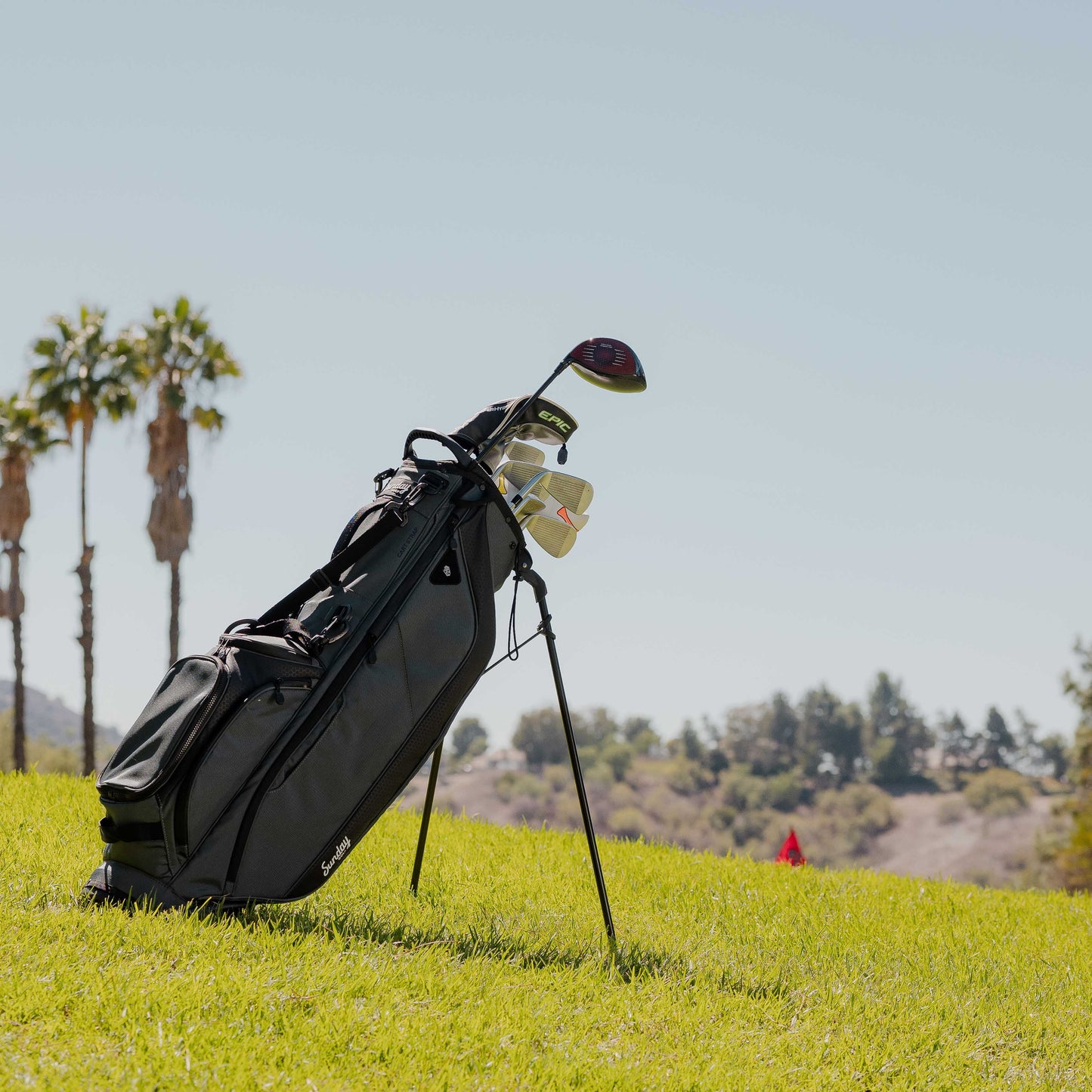Golf Bag Etiquette on the Course: The Essential Guide for Confident Play
Share
For many new and even experienced golfers, mastering the nuances of golf etiquette can be just as important as perfecting your swing. Among the most overlooked aspects is golf bag etiquette on the course. Knowing how to handle, place, and care for your golf bag not only shows respect for fellow players and the course, but also ensures a smoother, more enjoyable round for everyone. In this guide, we’ll break down everything you need to know about golf bag etiquette, including practical tips, common mistakes, and pro insights to help you play with confidence.
Why Golf Bag Etiquette Matters
Golf is a game steeped in tradition and respect—for the course, for your playing partners, and for the game itself. Proper golf bag etiquette is a key part of this culture. It helps maintain the pace of play, keeps the course in top condition, and fosters a positive experience for all golfers. Whether you’re walking with a stand bag, riding in a cart, or carrying a lightweight Sunday bag, understanding the dos and don’ts can set you apart as a considerate and prepared player.
1. Where to Place Your Golf Bag on the Course

One of the most common questions for beginners is: Where should I put my golf bag during a round? The answer depends on the situation, but the goal is always to keep play moving and avoid damaging the course.
On the Tee Box
-
Place your bag well off the teeing area, ideally on the side that leads to the next hole.
-
Avoid blocking other players’ swings or sightlines.
-
If you’re playing in a group, line up bags neatly to keep the area tidy.
On the Fairway
-
Set your bag on the rough or fringe, not directly on the fairway.
-
Position your bag on the side closest to your next shot or the green, so you don’t have to backtrack after hitting.
-
Never leave your bag in the middle of the fairway, as it can slow play and risk damage from other players’ shots.
Near the Green
-
Place your bag on the path to the next tee, but well away from the putting surface and fringe.
-
Never set your bag on the green or in a bunker.
-
Try to anticipate the flow of play, so you can exit the green efficiently after putting out.
For more on choosing a bag that’s easy to maneuver and place, explore our Lightweight Golf Bags collection.
2. How to Carry Your Golf Bag Properly

Carrying your bag correctly is essential for both etiquette and personal comfort. Here’s how to do it right:
-
Use both straps (if your bag has a dual-strap system) to distribute weight evenly and reduce fatigue.
-
Keep your bag close to your body, with the clubs facing behind you.
-
When setting your bag down, use the stand mechanism (if available) and avoid dropping it, which can damage both the bag and clubs.
-
Be mindful of where you swing your bag—avoid bumping into other players or their bags.
If you’re shopping for a bag that’s comfortable to carry, check out the Loma XL Carry Bags for a lightweight, ergonomic option.
3. Golf Cart Etiquette with Your Bag

Many golfers use carts, especially on longer or hilly courses. Here’s how to practice good etiquette with your bag when riding:
-
Secure your bag properly in the cart to prevent it from falling or shifting.
-
Only drive carts on designated paths or fairways as directed by course rules.
-
When approaching your ball, park the cart on the side closest to your next shot or the exit path.
-
Take only the clubs you need to your ball to avoid repeated trips to the cart, which can slow play.
-
After finishing the hole, load your bag quickly and move to the next tee before organizing clubs or accessories.
For bags designed to fit perfectly on carts and provide easy access, visit our Big Rig Cart Bags collection.
4. Respecting the Course: Where NOT to Place Your Bag
Protecting the course is a fundamental part of golf etiquette. Avoid placing your bag in these areas:
-
On the green: Even lightweight bags can damage the delicate putting surface.
-
In bunkers: Bags can disrupt the sand and create unfair lies for others.
-
On teeing grounds or fringes: These areas are maintained for play, not for bag storage.
-
In the line of play: Keep your bag out of the way of shots from other players.
Always look for a safe, out-of-the-way spot that allows you to move quickly and doesn’t interfere with others.
5. Keeping the Pace: Bag Placement and Ready Golf
Slow play is one of the biggest frustrations in golf. Smart bag placement can help you play faster and more efficiently:
-
After hitting, walk directly toward your next shot, carrying or rolling your bag with you.
-
On the green, place your bag between the hole and the next tee for a quick exit.
-
Prepare for your next shot while others are playing, so you’re ready when it’s your turn.
For more tips on choosing the right bag for your playing style, compare our models on the Sunday Golf Bag Comparison Page.
6. Group Play: Bag Etiquette with Others
When playing in a group, be mindful of your bag’s position relative to others:
-
Don’t block another player’s path or sightlines with your bag.
-
Keep bags neatly organized at tee boxes and greens to avoid confusion.
-
If you’re sharing a cart, communicate with your partner about where to place bags for easy access.
-
Help others by moving your bag if it’s in their way, and always return the favor.
7. Caring for Your Bag and Gear
Proper etiquette extends to caring for your own equipment:
-
Don’t drag your bag or drop it carelessly, as this can damage both the bag and clubs.
-
Keep your bag clean and organized—store tees, balls, and accessories in their designated pockets.
-
Use a rain hood or cover in wet weather to protect your clubs and bag.
-
Check your bag for forgotten items before leaving each hole, especially if you’re using multiple accessories.
Find smart storage solutions in our Golf Accessories collection.
8. Special Situations: Par 3s, Kids, and Walking-Only Courses
Some situations call for special attention to bag etiquette:
Par 3 Courses
-
Use a compact or Sunday bag for quicker play and easier movement.
-
Keep your bag off the teeing area and close to the exit path.
See our Loma Par 3 Golf Bags for ideal options.
Kids and Junior Golfers
-
Teach young players to place their bags safely and respectfully from the start.
-
Choose lightweight, easy-to-carry bags for juniors.
Explore our Recess Kids Golf Bags for junior-friendly designs.
Walking-Only Courses
-
Opt for a stand bag or carry bag with comfortable straps.
-
Plan your route to minimize walking and keep pace.
Browse our El Camino Walking Golf Bags for top recommendations.
Common Golf Bag Etiquette Mistakes to Avoid
-
Leaving your bag in front of the green, forcing others to walk around it.
-
Blocking cart paths or walkways with your bag.
-
Setting your bag down in wet or muddy areas, which can damage the course and your gear.
-
Forgetting to zip pockets or secure valuables, leading to lost items.
Pro Tips for Advanced Golf Bag Etiquette
-
Personalize your bag with a name tag or patch for easy identification—see our Bag Personalization Page.
-
Use a towel or club cover to keep your clubs and bag clean between shots.
-
Carry a small trash bag for wrappers or used tees to keep the course clean.
-
Practice the "leave no trace" principle: leave each area as you found it.
Choosing the Right Bag for Your Game
Good etiquette starts with the right equipment. Sunday Golf offers a wide range of bags to suit every type of player and course. Whether you need a lightweight carry bag, a cart bag with ample storage, or a junior bag for your child, you’ll find the perfect fit in our Golf Bags Collection.
Conclusion: Play with Confidence and Respect
Golf bag etiquette may seem like a small detail, but it makes a big difference on the course. By following these guidelines, you’ll not only show respect for the game and your fellow players, but also enjoy a smoother, more enjoyable round. Remember, the right bag can make etiquette easy—so explore our collections and play your next round with confidence!
Ready to upgrade your golf bag experience? Explore our full range of Golf Bags and Accessories to find your perfect match.



